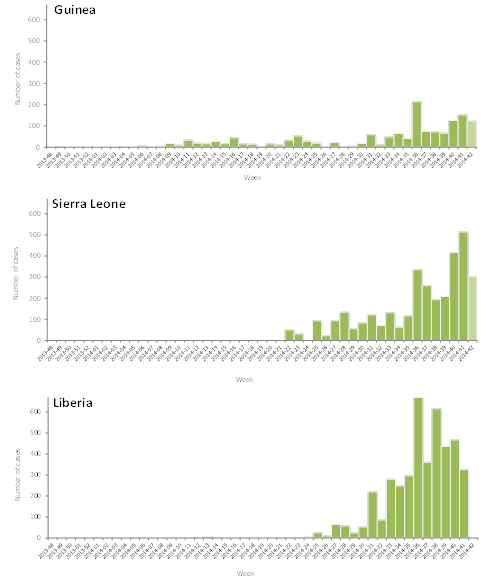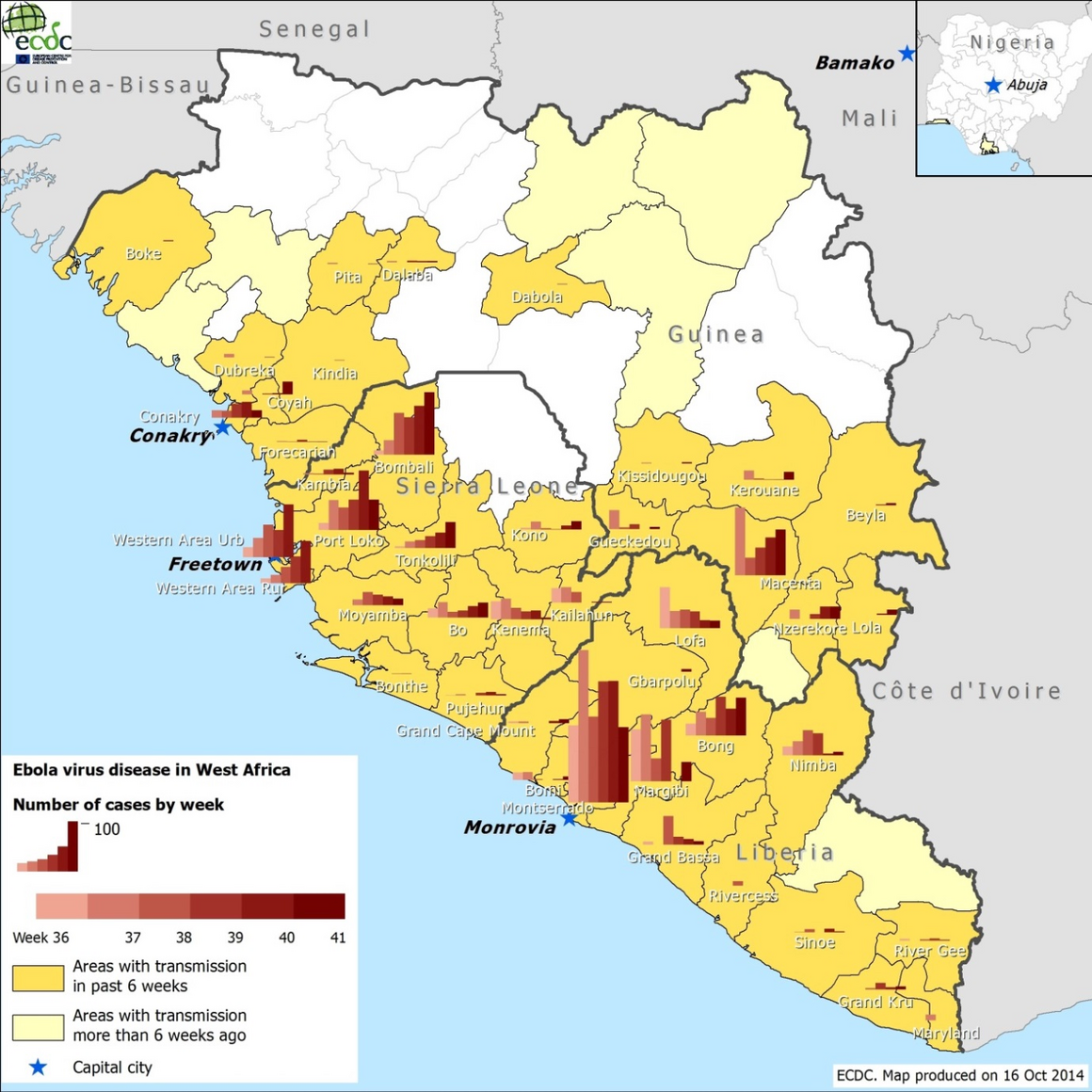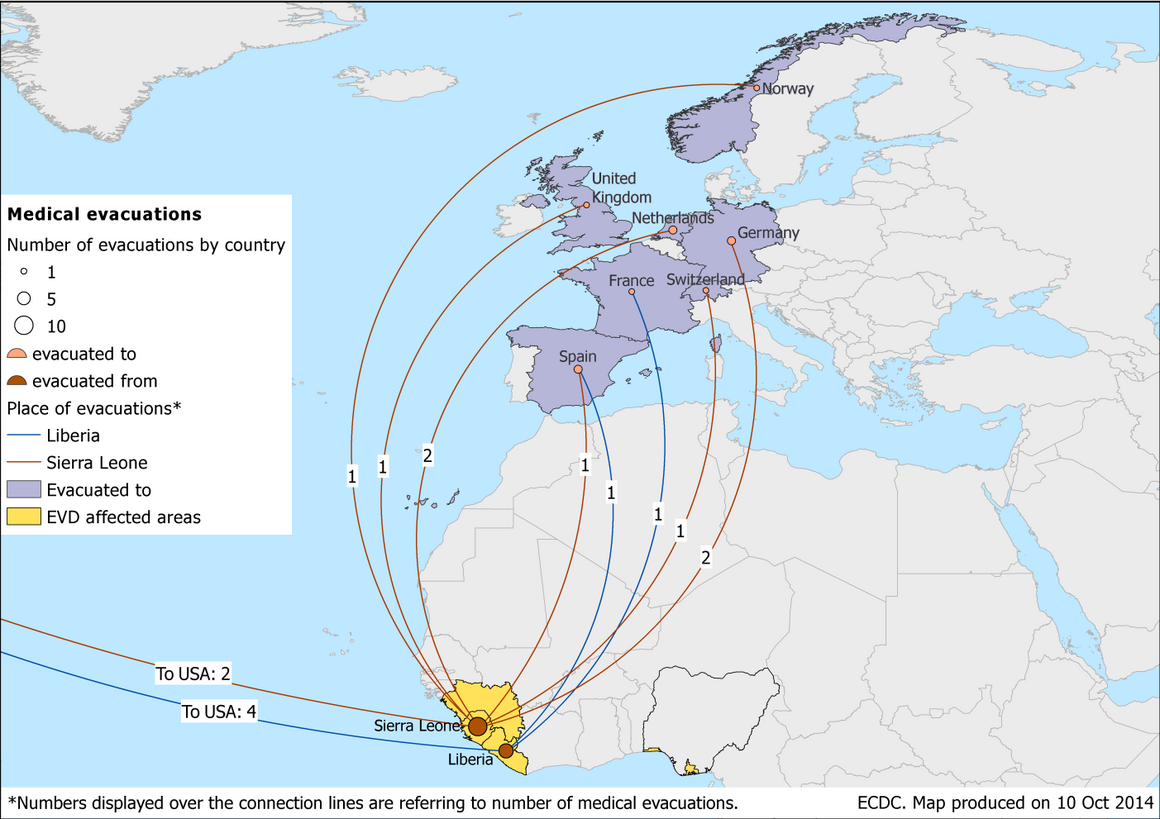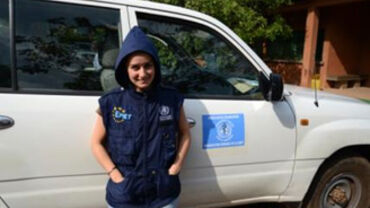Epidemiological update: outbreak of Ebola virus disease in West Africa
The latest epidemiological information on the outbreak affecting West Africa.
Chronology of events – key dates
22 March 2014: The Ministry of Health in Guinea notified WHO about a rapidly evolving outbreak of Ebola viral disease (EVD) [1]. The first cases occurred in December 2013. The outbreak is caused by a clade of Zaïre ebolavirus that is related but distinct from the viruses that have been isolated from previous outbreaks in central Africa, and clearly distinct from the Taï Forest ebolavirus that was isolated in Côte d’Ivoire 1994–1995 [2-4]. The first cases were reported from south-eastern Guinea and the capital Conakry.
May 2014: Sierra Leone and Liberia reported the first cases [5,6]. The disease is assumed to have spread from Guinea through the movement of infected people over land borders.
End of July 2014: A symptomatic case travelled by air to Lagos, Nigeria, where he infected a number of healthcare workers and airport contacts before his condition was recognised to be EVD.
8 August 2014: WHO declared the Ebola outbreak in West Africa a Public Health Event of International Concern (PHEIC) [7]. On 22 September, WHO re-confirmed that the outbreak continued to constitute a Public Health Emergency of International Concern. 29 August 2014: The Ministry of Health in Senegal reported a confirmed imported case of EVD in a 21-year-old male native of Guinea.
18 September 2014: The United Nations Security Council recognised the EVD outbreak as a 'threat to international peace and security' and unanimously adopted a resolution on the establishment of an UN-wide initiative which focuses assets of all relevant UN agencies to tackle the crisis [8].
23 September 2014: A study published by the WHO Ebola response team forecasted more than 20 000 cases (5740 in Guinea, 9890 in Liberia, and 5000 in Sierra Leone) by the beginning of November 2014 [9]. The same study estimated the doubling time of the epidemic at 15.7 days in Guinea, 23.6 days in Liberia, and 30.2 days in Sierra Leone.
30 September 2014: The US Centers for Disease Control and Prevention (CDC) announced the first imported case of EVD in US linked to the current outbreak in West Africa.
3 October 2014: In Senegal, all contacts of the imported EVD case had completed the 21-day follow-up period without developing disease. No local transmission of EVD has been reported in Senegal. The imported case tested negative on 5 September and WHO declared Senegal free of Ebola on 17 October 2014 (two incubation periods after the last isolated case tested negative).
6 October 2014: The Spanish authorities reported a confirmed case of EVD in a healthcare worker who cared for the second of two EVD patients that were evacuated to Spain.
10 October: In the USA, a healthcare worker at Texas Health Presbyterian Hospital who cared for the first imported EVD patient tested positive for Ebola.
14 October: In the USA, a second healthcare worker at Texas Health Presbyterian Hospital who also cared for the imported EVD patient tested positive for Ebola.
Situation update
Since December 2013 and as of 12 October 2014, WHO has reported 8 994 cases of EVD in West Africa including 4 492 deaths.
The distribution of EVD cases by affected countries:•
- Guinea: 1 472 cases and 843 deaths as of 12 October 2014;
- Liberia: 4 249 cases and 2 458 deaths as of 11 October 2014;
- Sierra Leone: 3 252 cases and 1 183 deaths as of 12 October 2014;
- Nigeria: 20 cases and 8 deaths, with last confirmed case in Lagos on 5 September 2014 (37 days as of 12 October 2014) and in Rivers State on first September 2014 (41 days as of 12 October);
- Senegal: 1 case, no deaths, confirmed on 28 August 2014 (45 days as of 12 October). All contacts have completed 21 days of follow-up.
Distribution of cases of EVD by week of reporting in Guinea, Sierra Leone, Liberia, Nigeria and Senegal, weeks 48/2013 to 42/2014*, n= 8 994

*The bar for week 42/2014 does not represent a complete week. The solid green line represents the trends based on a five week moving average plotted on the fifth week of the moving average window. The figure includes one imported case in Senegal.
The WHO Ebola response team showed that the current EVD cases present a similar course of infection, signs and symptoms when compared to previous outbreaks of EVD [9]. The incubation period was estimated to be 11.4 days with serial interval of 15.3 days. The case-fatality ratio estimated among 4 010 cases with known clinical outcome in Guinea, Liberia and Sierra Leone was 70.8% (95% CI: 68.6–72.8%) with no noticeable difference between the countries.
Situation in Guinea, Sierra Leone and Liberia
Guinea, Liberia and Sierra Leone are experiencing widespread and intensifying transmission [10]. Officially reported figures are believed to be underestimates, particularly in Liberia and in Monrovia. The incidence is increasing in Guinea, notably in Coyah prefecture neighbouring Conakry. Macenta is still experiencing significant transmission, new cases have been reported in Beyla and Lola prefectures neighbouring Ivory Coast in the east, and in Boke neighbouring Guinea Bissau in the west. The most active transmission areas in Sierra Leone are Freetown and Western areas (urban and rural), the surrounding Bombali and Porto Loko districts, and Bo and Tonkolili districts.
Distribution of cases of EVD by week of reporting in the three countries with widespread and intense transmission as of week 42 2014*

* The bar for week 42/2014 does not represent a complete calendar week. Source: Data are based on official information reported by ministries of health up to the end of 12 October for Guinea and Sierra Leone and 11 October for Liberia [11]
Distribution of cases of EVD by week of reporting in Guinea, Sierra Leone, Liberia and Nigeria (as of week 41/2014)

Source: Data from ministry of health reports (probable and confirmed cases).
Situation in Nigeria
As of 12 October 2014, 20 cases, including eight deaths have been notified. The last case in Lagos was confirmed on 5 September 2014 and in Rivers State on 1 September 2014[12]. All 891 identified contacts in Nigeria (362 contacts in Lagos, 529 contacts in Port Harcourt) have completed the 21-day follow-up [10]. A second EVD-negative sample was obtained from the last confirmed case in Nigeria on 8 September 2014, and it is expected that Nigeria will be declared Ebola free on 21 October 2014.
Number of Ebola cases and deaths in healthcare workers in West Africa
As of 12 October 2014, WHO reported 425 healthcare workers infected with EVD of whom 236 died [10]. The table below details the distribution of cases and deaths among healthcare workers in four of the affected countries:
| Country | Healthcare worker cases (% of reported cases) | Healthcare worker deaths (% of reported deaths) |
|---|---|---|
| Guinea | 76 (5.2) | 40(4.7) |
| Liberia | 209 (4.9) | 96 (3.9) |
| Sierra Leone | 129 (4.0) | 95 (8.0) |
| Nigeria | 11 (55.0) | 5 (62.5) |
| Total | 425 (4.7) | 236 (6.0) |
Source: data are based on official information reported by Ministries of Health as of 12 October for Guinea and Sierra Leone and 11 October for Liberia. [10]
Situation outside of West Africa
USA
On 30 September 2014, the US CDC announced the first imported case of EVD linked to the current outbreak in West Africa. The patient, who was visiting relatives in the USA, had arrived recently from Liberia and was diagnosed with EVD in Dallas, Texas. He is reported to have had a high risk exposure in Liberia prior to travelling but was asymptomatic when leaving West Africa and when arriving in the USA on 20 September. He first developed symptoms around 24 September, sought medical care on 26 September and was hospitalised and isolated on 28 September 2014. He died on 8 October 2014.
The second confirmed case in the USA is a healthcare worker who cared for imported case. She was diagnosed on 10 October in Dallas, Texas and is currently hospitalised [13].
The third case in the USA was confirmed on 14 October in another health care worker at Texas Health Presbyterian Hospital who also cared for the first imported case Ebola patient [14]. She was self-monitoring her health after the exposure to the imported patient. According to US CDC, she travelled by air on 13 October, the day before reporting symptoms. Because of the proximity in time between the evening flight and first report of illness the following morning, CDC is contacting the 132 passengers on the Frontier Airlines flight. According to media, the patient has been transferred to Emory University Hospital in Atlanta [15].
SpainOn 6 October, Spanish authorities reported a confirmed case of EVD in a healthcare worker who had cared for the second EVD patient to be medically evacuated to Spain at La Paz-Carlos III hospital in Madrid. The evacuated patient arrived in Spain on 22 September and died on 25 September and the infected healthcare worker represents the first secondary transmission of Ebola virus outside of West Africa [16].
According to the Spanish Ministry of Health, she participated in the medical care of the repatriated patient and was wearing appropriate personal protection equipment (PPE). Her tasks did not include medical procedures. In accordance with protocol, she self-monitored her health status and first developed fever on the night of 29 September.
The Spanish authorities have initiated contact tracing and, as of 10 October, 72 contacts are being actively monitored of which of which 13 high-risk contacts are kept under quarantine.
Medical evacuations from EVD-affected countries
Seventeen individuals have been evacuated or repatriated from the EVD-affected countries . As of 13 October, there have been nine medical evacuations of confirmed EVD cases to Europe (three to Germany, two to Spain, one to the UK, one to France, one to Norway and one to Switzerland) and two exposed persons have been repatriated to the Netherlands.
Medical evacuations and repatriations from EVD-affected countries, as of 8 October 2014

Download the data:
The following data are available to download as .csv files.
- EVD epicurve data Cumulative number of cases and deaths for the five West African countries with reported EVD cases (Liberia, Guinea, Sierra Leone, Nigeria, Senegal). Source: WHO
- EVD map data Cumulative number of cases and deaths at subnational level of the five West African countries with reported EVD cases (Liberia, Guinea, Sierra Leone, Nigeria, Senegal). Source: National situation reportFor those weeks without reported data, the most recent figures were used as best estimate of the number of case).







